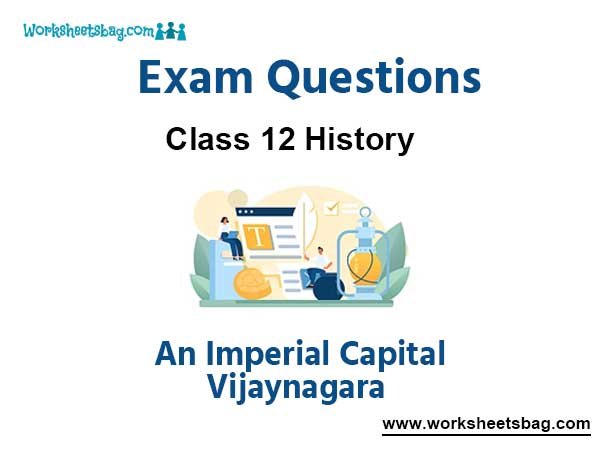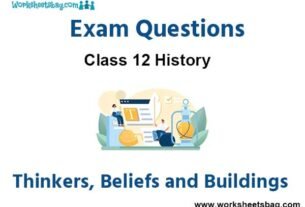Please see Chapter 7 An Imperial Capital: Vijaynagara Exam Questions Class 12 History below. These important questions with solutions have been prepared based on the latest examination guidelines and syllabus issued by CBSE, NCERT, and KVS. We have provided Class 12 History Questions and answers for all chapters in your NCERT Book for Class 12 History. These solved problems for An Imperial Capital: Vijaynagara in Class 12 History will help you to score more marks in upcoming examinations.
Exam Questions Chapter 7 An Imperial Capital: Vijaynagara Class 12 History
Very Short Answer Questions :
Question. What is the present name of Vijaynagar
Answer: Hampi.
Question. Who was Colonel Colin Mackenzie?
Answer: a) An employee of the English East India Company.
b) Ruins at Hampi were brought to light in 1800
Question. What do you know about Mandpam?
Answer: Mandapam were pillared outdoor hall for public rituals
Question. Local communities of merchants were known by which name ?
Answer: Kudirai Chetty.
Question. Writer the name of Capital / Capitals of Vijayanagar Empire .
Answer: Vijaynagar , Penukonda , Chandragiri , respectively .
Short Answer Questions :
Question. Describe the main features of the temples in Vijayanagara Empire.
Answer: 1. Architects were influenced by the Indo-Islamic architectural styles.
2. Huge structure of temple.
3. Gopuram and Mandapas.
4. Temples were the symbol of Kings Power and resource.
5. Building of story upon story above the “garbhagriha” called Vimana.
6. Architecture was ‘Dravida Style’ but it had its own distinct features.
7. Temples have a Kalyanamandapa, used to music, dance, drama etc.
Question. How were the water requirements of Vijayanagara met?
Answer: *Water requirements of Vijayanagara were met by the river Tungabhadra.
* Tanks were made to overcome this problem.
* Kamalapuram tank was used for irrigation and needs of the royal centers.
* Hiriya canal was the most prominent water works.
Question. What is Amara – Nayaka System?
Answer: It was a major political innovation of the Vijayanagara Empire.
– Many features of this system were derived from Delhi Sultanate.
Long Answer Questions :
Question. Describe the salient features of the administration of Vijayanagara Empire.
Answer: 1. The King.
2. Cabinet minister.
3. Provincial Government.
4. Local administration.
5. Judicial administration.
6. Financial administration.
7. Amar Nayak System.
Question. Describe the contribution of Krishnadeva Raya the greatest King of the Vijayanagara.
Answer: 1. His period is characterized by expansion and consolidation.
2. Broad toleration prevailed in his empire.
3. After a series of battles Vijayanagara emerged as a strongest military power.
4. Preach and Prosperity.
5. Efficient administration under his sway.
6. Productive agriculture.
7. Flourished inland coastal and overseas trade.
8. He was a great builder.
9. He was a scholar of Telugu and patron of Telugu, Kannada and Tamil poets.
10. He was a man of justice.
Question. Describe the main causes responsible for the downfall of Vijayanagara Empire.
Answer: Weakness of the Central Government.
1. Weak successor.
2. Rules of the different dynasties.
3. Continuos struggles against Bahamani Empire.
4. Role of Army.
5. Battle of Talikota.
Passage based Question :
The bazaar Paes gives a vivid description of the bazaar: Going forward, you have a broad and beautiful street … In this street live many merchants, and there you will find all sorts of
rubies, and diamonds, and emeralds, and pearls, and seed-pearls, and cloths, and every other sort of thing there is on earth and that you may wish to buy. Then you have there every evening a fair where they sell many common horses and nags, and also many. citrons, and limes, and oranges, and grapes, and every other kind of garden stuff, and wood; you have all in this street. More generally, he described the city as being “the best provided city in the world” with the markets “stocked with provisions such as rice, wheat, grains, India corn and a certain amount of barley and beans, moong, pulses and horsegram” all of which were cheaply and abundantly available. According to Fernao Nuniz, the Vijayanagara markets were “overflowing with abundance of fruits, grapes and oranges, limes, pomegranates, jackfruit and mangoes and all very cheap”. Meat too was sold in abundance in the marketplaces. Nuniz describes “mutton, pork, venison, partridges, hares, doves, quail and all kinds of birds, sparrows, rats and cats and lizards” as being sold in the market of Bisnaga (Vijayanagara).
Question. What did Fernao Nuniz say about market of vegetables?
Answer: Overflowing with abundance of fruits, grapes and oranges, limes, pomegranates, jackfruit and mangoes and all very cheap”. Meat too was sold in abundance in the marketplaces.
Question. What kind of arrangements were there for the provision of water in Vijayanagar empire?
Answer: Natural basin of Tungabhadra; Streams from the rocky outcrops; Kamalapuram Tank; Hiriya canal.
Question. How did Ibn Battuta describe about the bazaar?
Answer: All sorts of rubies, and diamonds, and emeralds, and pearls, and seed-pearls, and cloths; merchants living here; every evening a fair where they sell many common horses and nags, and also many citrons, and limes, and oranges, and grapes, and every other kind of garden stuff and wood.

